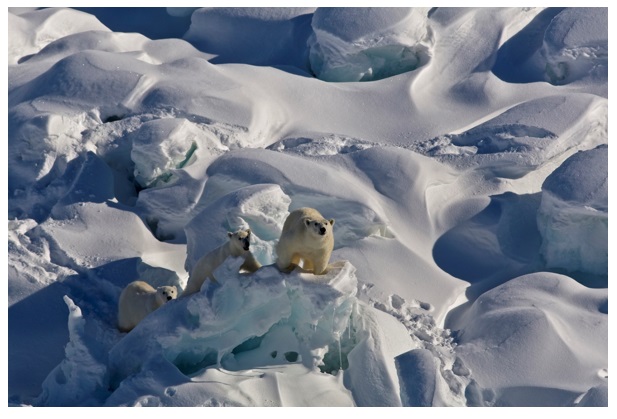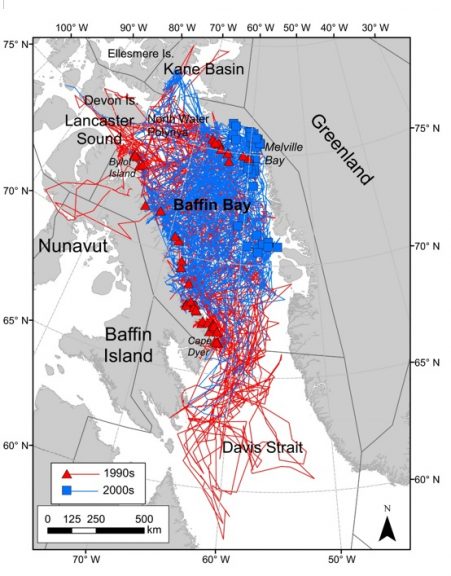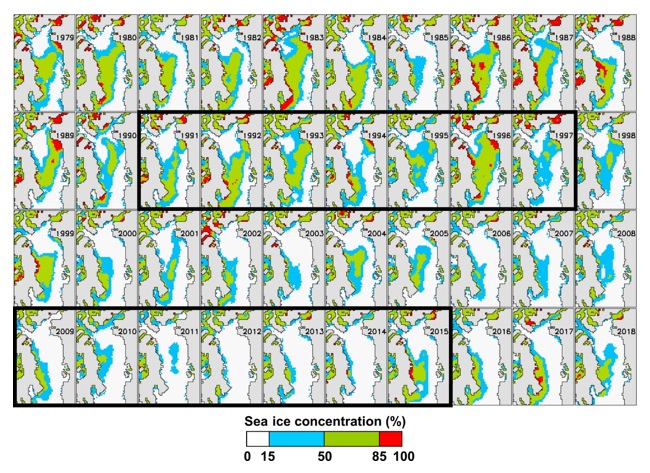Polar bear twins will be a rare sight in Baffin Bay in 2050 Published 02.03.2020

A scientific article published in February has attracted great international attention. The article, which was published in the respected scientific journal “Ecological Applications”, concludes, among other things, that female polar bears in Baffin Bay in 2050 will give birth to only one cub at a time instead of twins which is the standard today.
Senior scientist Kristin Laidre, Greenland Institute of Natural Resources and University of Washington in Seattle is the main author of the article. Among the co-authors is also pensioned senior scientist Erik W. Born, who was Greenland’s polar bear and walrus scientist for decades.
Utilising satellite tracking, biological measurements and sampling, as well as satellite imagery, the scientists studied the polar bears’ biology in relation to the sea ice in Baffin Bay. The conclusion was that movement patterns, body condition as well as the number of cubs per litter are affected by the decline of sea ice. In line with the fact that the open water season gradually have become longer, the polar bears spend 30 days more on land, when comparing the period 2009-2015 with 1991-1997. They have also become thinner, and the females give birth to less cubs now that there is less sea ice in summer. A projection of the situation in 2050 suggests that less females will have twins in approx. 30 years.
The article has been brought up by several media around the world, such as CNN, NASA and Metro UK. Many Twitter and Instagram profiles mention the study, including the actor Leonardo Di Caprio’s Instagram profile, which has 41 million followers, and which is focusing on the effects of climate change.
The other articles, coming from the Greenlandic-Canadian studies in 2009-2015, show that the situation for the polar bears in Baffin Bay has become more difficult since they previously were studied in 1991-1997. The habitat of the Baffin Bay population has become smaller, it has moved farther north, and it has also become more isolated, which means that the Baffin Bay bears have less contact with polar bears from neighbouring populations. Furthermore, compared to earlier, the polar bears in Baffin Bay must now swim across greater distances to reach land, and they generally use sea ice of poorer quality. The adult females hibernate later when they have to give birth, and they spend less time in their winter lair. Also, the winter lairs are now situated significantly higher on the mountain sides.
The title of the new article is ”Interrelated ecological impacts of climate change on an apex predator”, and it can be found here: https://esajournals.onlinelibrary.wiley.com/doi/full/10.1002/eap.2071
The polar bear studies in Baffin Bay in 2009-2015 were financed by the Danish Environmental Protection Agency, the oil industry through the Government of Greenland, Pingortitaleriffik/Greenland Institute of Natural Resources and University of Oslo, among others. The study took place in a collaboration among scientists from Greenland, Nunavut, Canada, USA, Norway and polar bear hunters and local communities in Greenland and Nunavut.
For further information:
Fernando Ugarte feug@natur.gl / phone +299 361224 or Kristin L. Laidre klaidre@uw.edu

Figure 1. Catch sites and movements of the polar bears in 1991-1997 (red) and 2009-2015 (blue)

Figure 2. Sea ice in Baffin Bay 1 July from 1979 to 2018. The two periods, when the polar bears were tracked with satellite tracker are shown in the black rectangles.

Figure 3. A litter with two cubs, which is the most common today, will disappear by 2050, concludes new research (photo: F. Ugarte)

